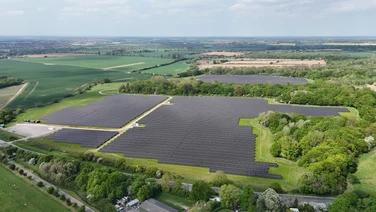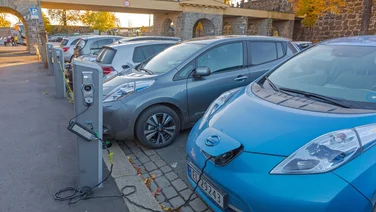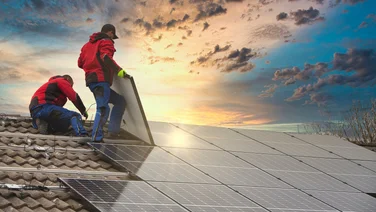We receive a small fee from trusted installers when you request a quote through our site. This helps us keep our content independent, well-researched and up to date – Learn more
- Carbon capture is a way of reducing global emissions
- The process is typically used in industries like steel and cement production
- It was first recorded in 1972
Green technology is advancing quickly. As more countries work towards reaching their net zero goals, politicians, businesses, and individuals are looking for more innovative ways to cut back on emissions.
This is where carbon capture comes in. It is a unique way of reducing global emissions and it has been around for decades – and yet, many people have only just started hearing about it.
In this guide, we cover what carbon capture is, how it works and whether it has a future in the energy industry.

What is carbon capture and storage?
Carbon capture and storage (CCS) does what it says on the tin – it literally captures carbon dioxide (CO2) emissions from industrial processes, and stores them in the ground.
The process is typically used in industries like steel and cement production, or to remove emissions from fossil fuels in power generation.
Believe it or not, this technology has been around for decades. According to the National Grid, the first carbon-capture system was created back in 1972, which has since captured and stored more than 200 million tonnes of CO2.
How does carbon capture and storage work?
There are three steps to carbon capture and storage:
- Capturing carbon dioxide – CO2 is separated from other gases that are produced in industrial processes. There are three basic types of CO2 capture: pre-combustion, post-combustion, and oxyfuel post-combustion:
- Pre-combustion – Converts fuel into a gaseous mixture of hydrogen and CO2. The hydrogen is separated and can be burnt without producing any CO2, and the CO2 can be compressed and stored
- Oxyfuel combustion – Uses oxygen rather than air for the combustion of fuel. This produces exhaust gas that is mainly water vapour and CO2, which can be easily separated to produce high-purity CO2
- Post-combustion – Separates CO2 from combustion-exhaust gases. The CO2 is captured using a liquid solvent or other separation methods. Once absorbed by the solvent, CO2 is then released and forms a “high-purity CO2 stream”
- Transport – The CO2 is then compressed and transported by road transport, ships, or through underground pipelines to a storage site
- Storage – Once it reaches the storage site, the CO2 is injected into rock formations underground, which typically run 1km deep. These storage sites are usually located at saline aquifers (geological formations) or depleted oil and gas reservoirs

What are the advantages of carbon capture?
Carbon capture has its advantages, including its benefit on the environment. We go into more detail in them below:
It can reduce emissions
Carbon capture has been touted as a secret weapon in the fight against climate change.
The International Energy Agency states that carbon capture could remove as much as 20% of total CO2 emissions from industrial and energy-production facilities – if it’s done properly.
This will be particularly useful for carbon-intensive industries. In fact, the Centre for Climate and Energy Solutions claims that CCS technology can remove more than 90% of CO2 emissions from power plants and industrial facilities.
It’s faster at removing CO2 than planting trees
Trees are nature’s carbon-capture tool. However, it takes years for saplings to absorb large amounts of CO2.
A typical tree can capture around 21 kilograms (kg) of CO2 per year – but that’s only once it’s fully grown after 20 years. Over the first 20 years of a tree’s life, it only actually absorbs 39kg of carbon dioxide.
Carbon capture, on the other hand, can reduce large amounts of CO2 emissions at the source.
We do, however, need to carry on planting trees to help biodiversity and restore damaged habitats. But since we’re in a race against climate change, the faster we reduce emissions, the better.
What are the disadvantages of carbon capture?
Although there are plenty of advantages, carbon capture does come with some disadvantages, as seen below:
It’s expensive
Capturing and storing carbon is a pricey process – one that’s not always successful either.
In fact, the US Department of Energy has spent more than $1bn (£804,634,684) on carbon capture projects since 2009, which have had ‘varying levels of success’.
It currently costs an average of $600 (£440) per tonne of CO2 absorbed, which isn’t ideal, given humans emit 36 billion tonnes of CO2 a year.
Thankfully, experts are working towards making carbon capture more affordable in the near future – though it’s not clear when this will happen.
The process is energy intensive
Carbon-capture systems eat through a lot of electricity, which comes down to the amount of thermal energy required, as well as the need to compress CO2 for storage.
CCS is also set to expand by 30% each year, with deployment reaching 30 gigatonnes of CO2 per year by the end of the century – this could consume a quarter of global energy supplies by 2100.
Reaching this goal would mean building some 30,000 large-scale CCS plants – all of which would need to run on electricity, which isn’t always ‘green’.
Carbon capture can increase emissions
If it’s done effectively, carbon capture can reduce emissions. However, experts have found that some projects are actually pumping out more CO2 than they’re saving.
A recent study suggested this comes down to the large amount of energy required to power carbon capture.
If a CCS facility has its own solar panel plant to harness renewable energy, then its operations will be completely green. However, if it runs on electricity from the grid, it will likely be pumping out emissions, since most countries around the world still rely on fossil fuels to generate electricity.
There are significant risks
Storing carbon can be risky. Although CO2 isn’t flammable, high levels of it can be harmful to human health.
Concentrated CO2 can cause headaches, dizziness, confusion, and loss of consciousness. There have even been some deaths caused by asphyxiation from high levels of CO2.
Another major concern is that CO2 could leak out of the underground reservoirs into the surrounding air, and either contribute to climate change or taint nearby water supplies.
Experts are also looking into whether carbon storage can lead to human-made tremors, which could be caused by the build-up of pressure underground.
- Can reduce emissions at the source
- Easier to remove CO2 than planting trees
- It's expensive
- It's energy intensive
- CO2 emissions can increase
- It has significant risks
Where is carbon capture and storage happening?
Countries around the world are looking into carbon capture to reduce emissions. According to the Global CCS Institute, there were tracking 115 CCS networks globally, and as of 2019, there 51 large-scale CCS facilities globally.
Broken down, 19 of these were in operation, four were under construction and the remainder are in various stages of development.
Out of these 51 sites, 24 were located in the Americas, 12 in Europe, 12 in Asia-Pacific, and 2 in the Middle East.
We’ve listed the three largest carbon-capture projects below.
Century Processing Plant
Location: Texas, US
The world’s largest carbon capture and storage plant is the Century Processing Plant, which is owned by Occidental Petroleum.
After a $1.1bn (£885m) investment, the plant began operating in November 2010, and now has the capacity to capture 8.4 million tonnes of CO2 a year.
Shute Creek Gas Processing Plant
Location: Wyoming, US
The Shute Creek Gas Processing Plant currently has the capacity to capture 7 million tonnes of CO2 each year.
The plant is owned by ExxonMobil, and uses Exxon, Anadarko, and ChevronTexaco pipelines to transport the CO2 from the Shute Creek facility.
In 2010, ExxonMobil completed an $86m (£68.72m) expansion at the plant to include Controlled Freeze Zone (CFZ) capture technology. This new procedure involves a separation process that freezes out and melts the CO2, removing any hydrogen sulphide, methane, and other components found in gas resources.
Great Plains Synfuels Plant
Location: North Dakota, US
The Great Plains Synfuels Plant currently has the capacity to capture and compress up to 3 million tonnes of CO2 a year.
Owned and operated by Dakota Gasification, the plant began production in 1984, and added carbon capture in 2000 after a $1.2bn (£1.68bn) investment.
The CO2 is captured through the pre-combustion method, and is transported through a 330km-long pipeline to the Weyburn and Midale oilfields.
Is carbon capture and storage a solution for the future?
On the one hand, carbon capture has the potential to remove huge amounts of CO2 from the atmosphere. Plus, new climate goals have led to more than 120 new industrial carbon-capture projects in recent years, which shows promise in the industry.
On the other hand, carbon capture is currently expensive, risky, and sometimes ineffective at reducing emissions.
Rollouts of CCS facilities are also happening slower than originally expected. The International Energy Agency (IEA) stated that this “deployment remains woefully below the level required in the Net Zero Emissions by 2050 Scenario”.
Many experts in the energy industry are working toward making these facilities more effective and affordable.
Chemists have created a new way to seize CO2, which reduces costs by 19% compared to current commercial technology. This new technology also uses 17% less energy, helping CCS become more eco-friendly over time.
Ultimately, the most problematic part of carbon capture is that it is a way for oil and gas giants to greenwash their products and carry on using finite fossil fuels.
By using carbon capture, many fossil-fuel companies are now claiming to have green products, when actually, many of their facilities are still consuming dirty energy through grid-sourced electricity.
Summary
- Carbon capture is a controversial topic
- The process has the potential to cut global carbon emissions, studies have found that some carbon-capture plants are doing more harm than good
- Moving forward, companies can look at new innovative ways to reduce costs and emissions in CCS
- To avoid consuming fossil fuels whilst capturing existing CO2 emissions, factories should also invest in solar panels to run off renewable energy
- Carbon capture has the potential to remove huge amounts of CO2 from the atmosphere








